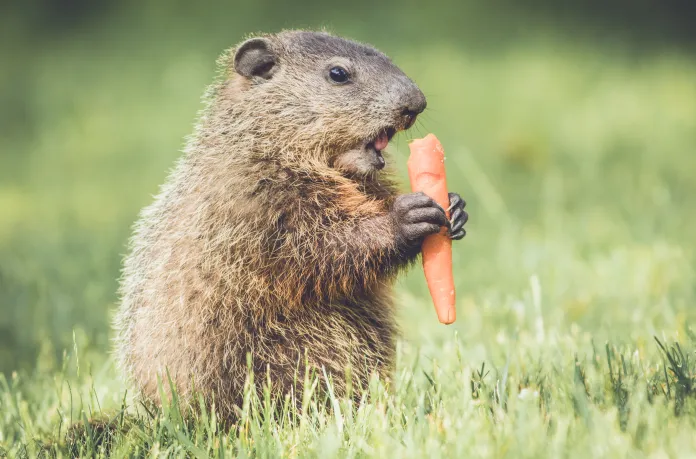Groundhogs, also known as woodchucks, are burrowing rodents that may become unwelcome guests in backyards and farms. Their robust appetite for vegetation can make them notorious among gardeners and farmers. If you’re wondering “what do groundhogs eat” and whether they pose a threat to your pets—especially cats—this article provides a comprehensive breakdown.

In short, groundhogs primarily eat plants and are not natural hunters of cats. While extremely rare, there have been isolated reports of groundhogs attacking small animals, such as kittens or chickens, typically when defending their burrows. However, groundhogs are herbivores by nature, and their main diet includes leaves, vegetables, and fruits.
The groundhog’s diet is largely herbivorous, but they may occasionally consume insects or protein sources when available.
| Food Category | Examples | Frequency |
|---|---|---|
| Green Vegetation | Clover, wild grasses, alfalfa, dandelions | Daily |
| Vegetable Garden Plants | Carrots, beans, peas, cabbage | Frequently (if accessible) |
| Fruits | Apples, berries, and other soft fruits | Occasionally |
| Insects and Grubs | Beetles, caterpillars, and earthworms | Opportunistically |
| Protein Sources | Baby birds, eggs (rare cases) | Rare and opportunistic |
Groundhogs spend a significant portion of their active hours foraging for vegetation. During warmer months, they may graze for up to 6 hours a day, filling their cheek pouches with leafy greens to bring back to their underground burrows for later consumption.
Their ability to consume large amounts of vegetation helps them store fat for hibernation in the colder months.
Although groundhogs are primarily herbivores, they can exhibit opportunistic feeding behavior:
Groundhogs may eat insects, larvae, and small grubs as a protein supplement.
In some rare cases, reports suggest groundhogs scavenging small animal carcasses, but it’s unclear whether they killed the animals or simply found them already dead.
Despite this, their teeth and claws are not well-suited for hunting prey like cats. Instead, their sharp incisors are adapted for gnawing through vegetation.
The short answer is no—groundhogs do not actively hunt cats. A healthy adult cat is generally too quick and defensive for a groundhog to catch or see as prey. However, kittens or very small cats could potentially be vulnerable, especially if they stray too close to a groundhog’s burrow.
While groundhogs are not inherently aggressive, there are specific scenarios where they might pose a threat to cats:
| Situation | Behavior | Explanation |
|---|---|---|
| Territorial Defense | Loud tooth chattering, stomping, and chasing | Groundhogs become territorial during mating season and will defend their burrows. |
| Protecting Offspring | Charging at perceived threats | Mother groundhogs may attack if they believe their young are in danger. |
| Cat Approaches Burrow | Potential for defensive bites or scratches | If a cat wanders too close to an occupied burrow, a groundhog may react defensively. |
Kittens and smaller breeds of cats may face a higher risk of being attacked due to their size. Larger adult cats, however, are more likely to intimidate a groundhog rather than be viewed as prey.
To minimize any risks of conflict between groundhogs and cats, follow these precautions:
Groundhogs are opportunistic eaters with an excellent sense of smell. Pet food left outdoors—whether kibble or canned food—can easily attract them to your property.
| Tip | Reason |
|---|---|
| Feed cats indoors | Prevents groundhogs from being lured by food scents |
| Store pet food in sealed containers | Avoids accidental spills that may attract wildlife |
Installing sturdy fencing is one of the best ways to prevent groundhogs from accessing your yard or garden areas.
| Fencing Feature | Details |
|---|---|
| Material | Galvanized hardware cloth or welded wire |
| Mesh Opening Size | 1/4 inch or smaller |
| Buried Depth | At least 12 inches underground |
| Angled Outward | Angle the fencing outward at the bottom to prevent digging |
Regularly inspect the fencing for holes or gaps and repair any weak points.
If groundhogs have already taken up residence in your yard, humane removal methods can help ensure the safety of your pets.
Repellents: Use natural deterrents like predator urine granules around known burrows.
Burrow Management: Plug up abandoned burrows with soil to prevent re-entry.
Professional Removal: If necessary, contact wildlife control experts to safely relocate groundhogs.
When relocating groundhogs, ensure they are released in a suitable environment away from busy roads and residential areas.
When a groundhog feels threatened, it may display the following defensive behaviors:
Tooth Chattering: An audible clattering of their teeth, indicating they feel threatened.
Foot Stomping: Rapid stomping of their feet to warn intruders to stay away.
Charging: Running toward the perceived threat to scare it off.
Cats that notice these behaviors are usually quick to retreat, but kittens may not recognize the warning signs as quickly.
Groundhogs are primarily plant-eaters, with diets that focus on vegetation like clover, dandelions, and garden vegetables. While they may eat insects or scavenged meat occasionally, their teeth and claws are not adapted for hunting.
Direct attacks on cats are rare and usually occur when a groundhog is provoked, protecting its young, or defending its territory. By following precautions—such as keeping pet food indoors, using exclusion fencing, and removing groundhogs humanely—you can help create a safe environment for both your cats and the local wildlife.
In summary, understanding what groundhogs eat and their typical behavior will help you reduce unwanted encounters and maintain a peaceful coexistence between your furry companions and these burrowing visitors.
animal tags: groundhogs
We created this article in conjunction with AI technology, then made sure it was fact-checked and edited by a Animals Top editor.